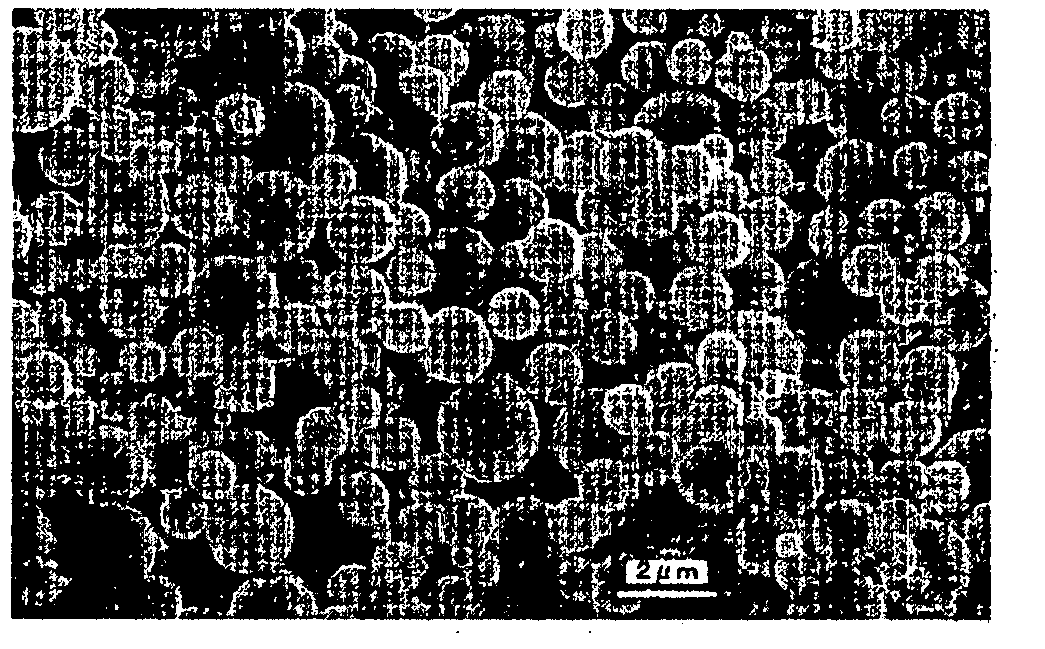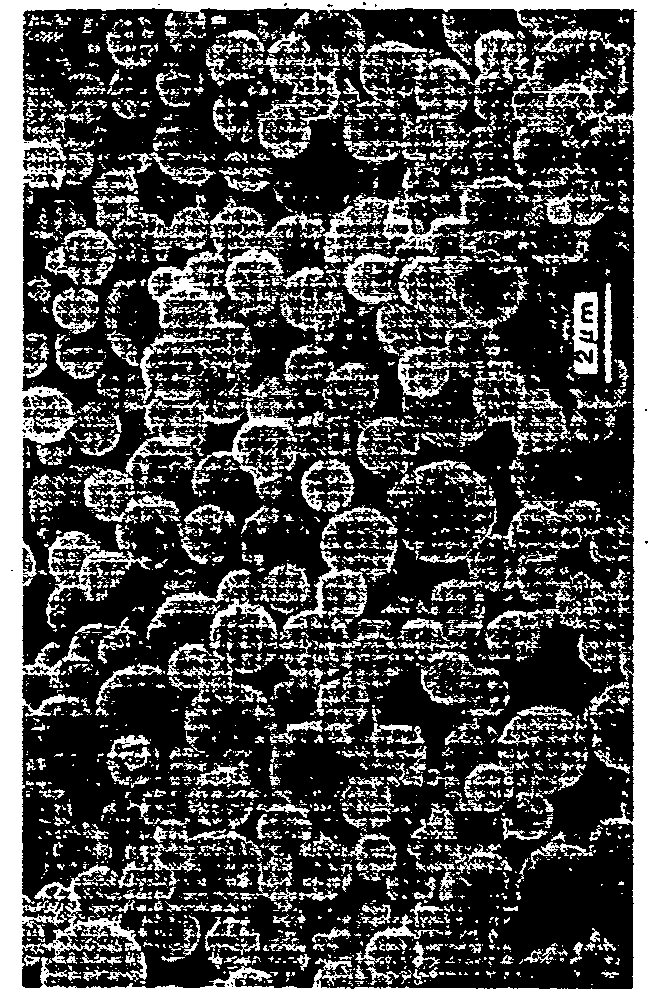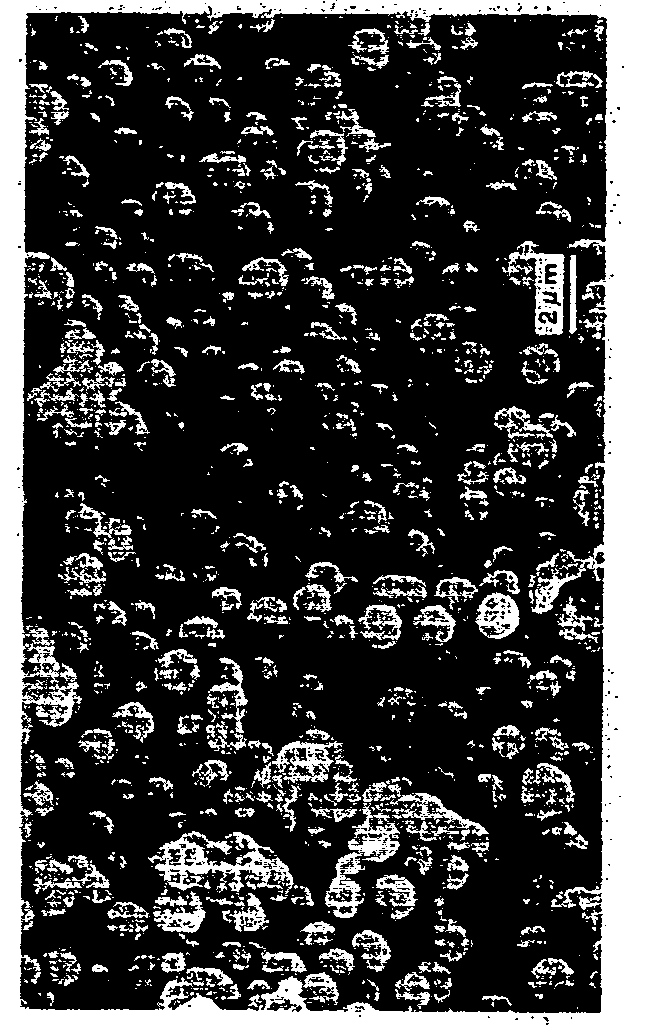Process for producing luminant excitable with vacuum ultraviolet radiation, luminant excitable with vacuum ultraviolet radiation and luminous element including the same
a technology of vacuum ultraviolet radiation and luminant, which is applied in the direction of discharge tube luminescent screen, gas-filled discharge tube, luminescent composition, etc., can solve the problems of low purity, high power consumption, and lower luminous efficiency of pdp's compared to crt's, so as to reduce the amount of defects, increase crystallinity, and reduce heat degradation
- Summary
- Abstract
- Description
- Claims
- Application Information
AI Technical Summary
Benefits of technology
Problems solved by technology
Method used
Image
Examples
embodiment 1
[0124] (1) A raw material solution was obtained by dissolving 0.018 mol of barium nitrate (Ba(NO3)2), 0.02 mol of Mg(NO3)2—6H2O, 0.2 mol of Al(NO3)3—9H2O, 0.002 mol of Eu(NO3)3—2.4H2O in 1 L of distilled water. This raw material solution was introduced into a microchannel atomizing device at a rate of 100 mL per hour and was atomized as a micromist. Together with 5% Ar—N2 gas, this was introduced into a tubular electric furnace set at 1300 degrees C. This was heated for 3 seconds while passing through (reaction step). The resulting spherical fine particles were collected by a collection apparatus. With electron microscope observation and particle distribution analysis, the resulting particles were seen to be truly spherical with average particle diameter D50 of 1.0 micrometers.
[0125] The luminous intensity when the luminescent particles are used in a plasma display is shown in Table 1. In the table, heat degradation was evaluated as the maintenance rate of luminous intensity after ...
embodiment 2
Example of Ultrasonic Type Atomizer
[0135] A raw material solution was obtained by dissolving 0.18 mol of barium acetate (Ba(CH3COO)2), 0.2 mol of Mg(NO3)2—6H2O, 2 mol of Al(NO3)3—9H2O, 0.02 mol of Eu(NO3)3—2.4 H2O in 3 L of distilled water. This raw material solution was introduced into an ultrasonic atomizing device at a speed of 200 mL / hour and was atomized to a micromist. Together with 5% H2—N2 gas, the micromist was introduced into a tubular electric furnace set at 1300 degrees, and reaction baking was conducted. The resulting spherical fine particles were collected with a collection apparatus and maintained at 100 degrees. The resulting particles were spherical with an average particle size of 1.0 micrometers.
[0136] Even with a very short baking time (seconds), the spherical fine particles had a luminous intensity of 60% or greater immediately after atomization. With similar baking times, ones produced by the solid phase reaction method did not emit any light.
[0137] In this ...
embodiment 3
[0139] A raw material solution was obtained by dissolving 0.018 mol of barium nitrate (Ba(NO3)2), 0.02 mol of Mg(NO3)2—6H2O, 0.2 mol of Al(NO3)3—9H2O, 0.002 mol of Eu(NO3)3—2.4 H2O in 3 L of distilled water. This raw material solution was introduced into an ultrasonic atomizing device at a speed of 200 mL / hour and was atomized to a micromist. Together with 5% H2—N2 gas, the micromist was introduced into a tubular electric furnace set at 1300 degrees, and reaction baking was conducted. The resulting spherical fine particles were collected with a collection apparatus and maintained at 100 degrees. The resulting particles were spherical with an average particle size of 0.5 micrometers. After re-baking, the particle size was slightly smaller than after atomization and was 0.45 micrometers. The luminous properties were similarly improved (see Table 1).
Embodiment 4 an Example Using AlF3
[0140] A raw material solution was obtained by dissolving 0.018 mol of barium nitrate (Ba(NO3)2), 0.02...
PUM
| Property | Measurement | Unit |
|---|---|---|
| particle size | aaaaa | aaaaa |
| density | aaaaa | aaaaa |
| pore size | aaaaa | aaaaa |
Abstract
Description
Claims
Application Information
 Login to View More
Login to View More - R&D
- Intellectual Property
- Life Sciences
- Materials
- Tech Scout
- Unparalleled Data Quality
- Higher Quality Content
- 60% Fewer Hallucinations
Browse by: Latest US Patents, China's latest patents, Technical Efficacy Thesaurus, Application Domain, Technology Topic, Popular Technical Reports.
© 2025 PatSnap. All rights reserved.Legal|Privacy policy|Modern Slavery Act Transparency Statement|Sitemap|About US| Contact US: help@patsnap.com



